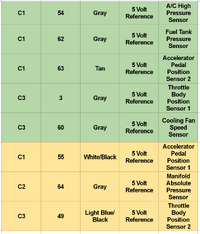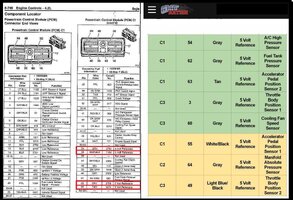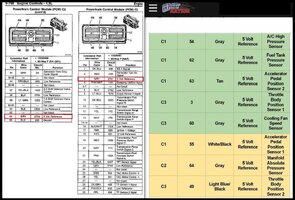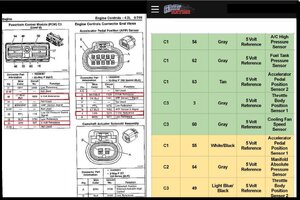The possible explanations are:
(1) The CKP "Crankshaft Sensor" is NOT a True "Sensor"...in the Strictest 'Sense' of that Word. Rather, it is a highly reliable Electro-Magnetic Induction Device (originally conceived by Michael Faraday) having a very fine, Wire Wound Coil wrapped around a Permanent Magnet. This unit creates a Mild, Alternating Current Field (A/C) producing a Sine Wave by the passage in close proximity with the 60 (-2) Steel Teeth evenly cut into the OD of the rotating Crankshaft 58 Tooth Reluctor Ring in the Late Model GMT360s.
The Vacant (-2) Teeth Spacing in the OD of the Reluctor Wheel provides an Arbitrary Break in the Cycle necessary to coincide with Top Dead Center of the #1 Cylinder during 720 Degrees of Crankshaft Rotation. Therefore, each Reluctor "Tooth" represents a predictable 6 Degrees of Motion of the Crankshaft rotating within a full 360 Degree Circle.
Consequently, the CKP Device does not require a 5 Volt Reference Signal in the same manner that a Hall Effect Sensor would in order to perform its function. In some vehicles, there is a Separate Module included in the Engine Management System that interfaces with, interprets and converts the CKP A/C Sine Wave over to a Hall Effect Signal in order to make it easier for the PCM-ECM to make its 'mechanical positional comparison checks' between where the Crankshaft and Camshaft(s) are at all times using the input from the CPS Exhaust Camshaft Position Hall Effect Sensor as "The Foil".
This fallible predictability helps to determine whether or not Proper Ignition Timing - Spark Plug Firing and EFI Pulsing are all behaving and doing their parts when all of these events are truly in their correct, relative positions within the 720 Degree, Four Stroke Combustion Cycle. Conversely, they also serve to point out the irreconcilable differences that can happen when Mechanical Failures are developing in High Mileage Motors with Worn Timing Chains, Over-Extended Timing Chain Tensioners and Worn-In Grooved Plastic-Nylon Timing Chain Guides.
(2) Likewise, rather than being "True Sensors"... the Two Knock Sensors are actually "Piezoelectric" Devices that rely upon Engine Vibrations "In Excess" to generate Mild Electrical Signals by the simple action of the Bending or Flexing of its Crystal Substrate. This phenomena only occurs when the Motor shakes with sufficient violence from 'Engine Knocks' to bend and flex the minute, suspended Crystals inside of their 'Hollow Chambers'.
Such events will cause the Crystals to generate Minute Electrical Currents that can be picked up by the PCM after a certain number of these events occur over a set time frame. Whether the PCM deems this a problem or not is dependent upon BOTH Knock Sensors signalling their cascade to the PCM, allowing it to help interpret problems such as "Poor Quality or Low Octane Fuel, Pre-Ignition events from a Damaged Spark Plug, Excessive Compression from having Incorrect Head Gasket 'Quench' or Incorrect Piston Height in Turbo-Charged Applications. Thus... they can help determine these conditions and No 5 Volt DC Reference Signal is actually necessary for them to 'work'.






